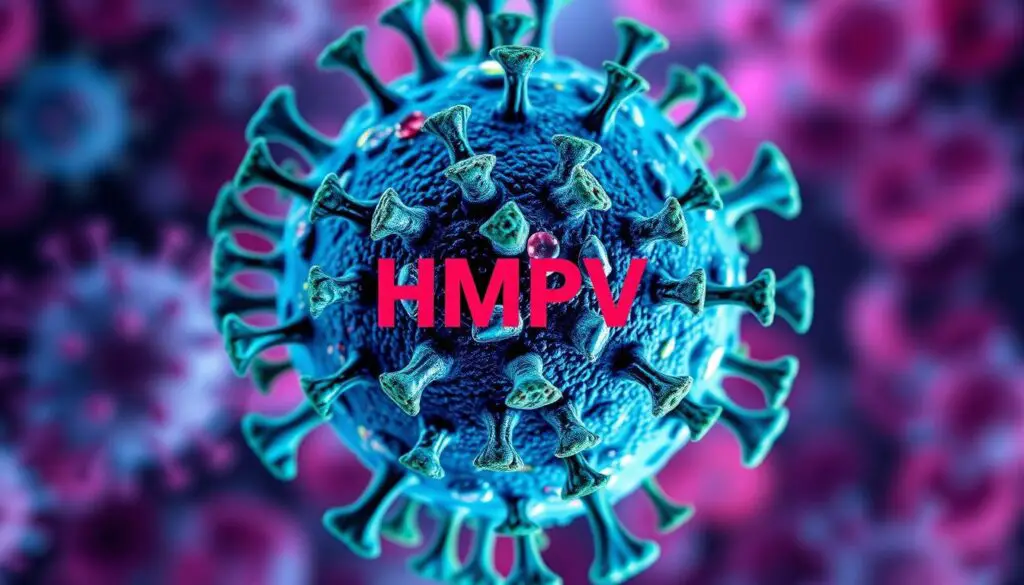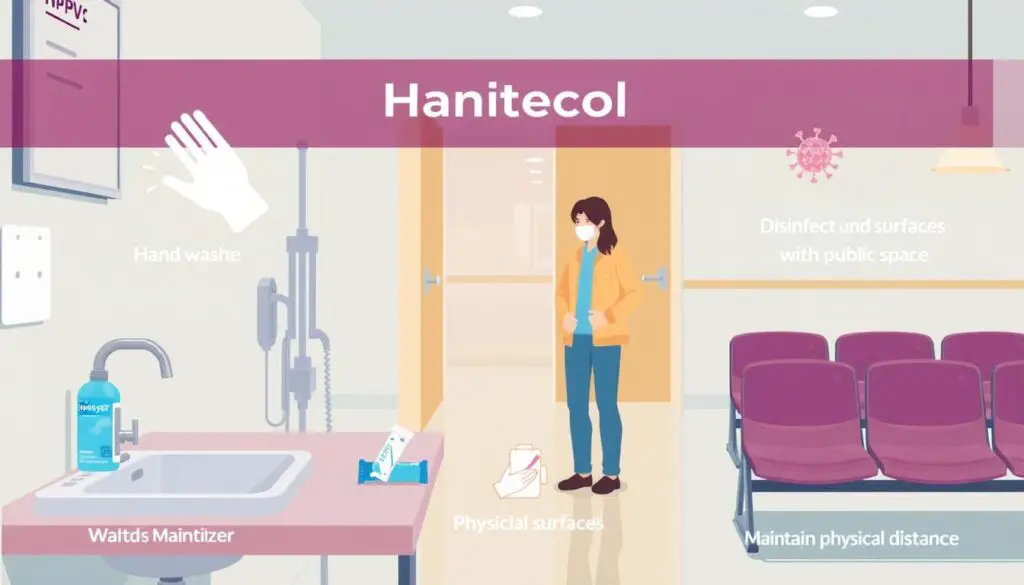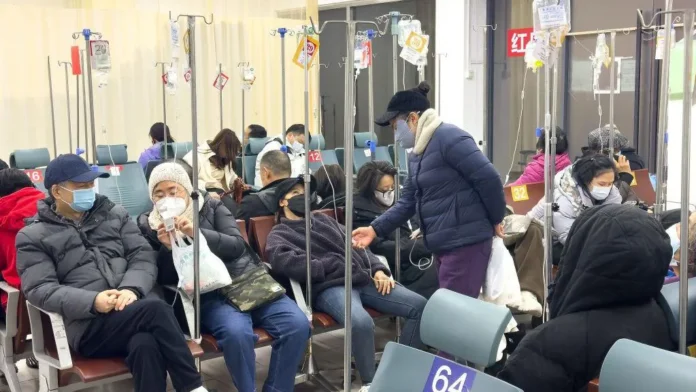Human metapneumovirus, or HMPV, affects people of all ages. It can cause symptoms from mild to severe. Knowing how it spreads and how to stop it is crucial.
HMPV was discovered in 2001 and has since become a major respiratory illness worldwide. Understanding HMPV and its health impact is vital for prevention and treatment.
Key Takeaways
- HMPV is a highly contagious respiratory virus
- It can cause a range of symptoms, from mild to severe
- HMPV affects people of all ages
- Understanding how HMPV spreads is essential for prevention
- HMPV is a significant concern for global health
- Effective prevention and treatment strategies are crucial for managing HMPV
What is Human Metapneumovirus (HMPV)?
Human metapneumovirus, or HMPV virus, is a respiratory virus that affects people of all ages. It was first identified in the Netherlands in 2001. Since then, it has become a major cause of respiratory infections worldwide.

The HMPV virus belongs to the Pneumoviridae family. This family includes viruses like the respiratory syncytial virus (RSV). Understanding the classification of HMPV helps us see its global health impact. The World Health Organization (WHO) has recognized HMPV as a key player in respiratory illnesses, especially in children and older adults.
History and Discovery of HMPV
The discovery of HMPV has improved our knowledge of the virus and how it spreads. Researchers have found several genotypes of HMPV. This discovery has helped in creating diagnostic tests and treatment plans.
Classification as a Respiratory Virus
HMPV is a single-stranded RNA virus that mainly affects the respiratory tract. It is very contagious. It can spread through close contact, contaminated surfaces, or airborne transmission.
Impact on Global Health
HMPV has a big impact on global health, causing millions of respiratory infections each year. It has been found in many countries. Its spread often leads to outbreaks of respiratory illness.
More research is needed to fully understand HMPV. But, it’s clear that HMPV is a major public health concern. It needs ongoing attention and study.
Common Symptoms of HMPV Infection
Human metapneumovirus symptoms can be mild or severe. It’s important to know the common signs of HMPV infection. People with HMPV may have respiratory symptoms like coughing, sneezing, and a runny nose. These symptoms can be similar to those of the common cold or flu.
Some common HMPV symptoms include:
- Fever
- Chills
- Headache
- Body aches
- Sore throat
HMPV symptoms can vary in severity. They may be more severe in young children, older adults, and people with weakened immune systems. If you think you or someone else has HMPV, watch the symptoms closely. Seek medical help if needed.
Knowing the symptoms of human metapneumovirus is key for quick diagnosis and treatment. By recognizing these signs, you can help prevent the virus’s spread. And if necessary, seek medical attention.
HMPV Transmission and Risk Factors
Understanding how Human Metapneumovirus (HMPV) spreads is key to preventing it. How do you get human metapneumovirus? It spreads through coughing, sneezing, touching contaminated surfaces, and close contact with someone who’s sick.
Several factors can increase the risk of HMPV spreading. Not washing hands often, living in crowded places, and having a weak immune system are some. Young kids, older adults, and people with health issues are more likely to get it.

- Being close to someone who’s sick
- Not keeping hands clean
- Having a weak immune system
- Health problems
- Being young or old
Knowing these points can help you avoid getting HMPV. It also helps keep others safe from it.
| Group | Risk Level |
|---|---|
| Young children | High |
| Older adults | High |
| People with underlying health conditions | High |
| Healthy adults | Low |
Understanding HMPV Rash and Other Complications
Human metapneumovirus (HMPV) infections can cause hmpv rash. This rash is common in children. It’s important to know about the rash, how it’s diagnosed, and how to treat it.
Some common problems from HMPV include:
- Respiratory issues like bronchiolitis and pneumonia
- hmpv rash, which can be itchy and uncomfortable
- Ear infections, which can cause hearing loss if not treated
HMPV complications can be serious, especially for older adults and young children. If symptoms get worse, it’s important to see a doctor.
Knowing about HMPV risks and complications helps prevent them. Being aware of human metapneumovirus complications helps manage health. This reduces the chance of severe problems.
Diagnosing HMPV Infections
It’s important to diagnose HMPV infections quickly to treat them effectively. Healthcare experts use different tests to find out if someone has the virus. These tests include molecular methods like PCR and serological tests that look for HMPV antibodies.
Testing Methods
There are many ways to test for HMPV. Some include:
- Nasal swabs or throat swabs for molecular tests
- Serological tests to find HMPV antibodies
- Imaging tests, like chest X-rays, to check for other infections
When to Seek Medical Attention
If you have symptoms like fever, cough, or trouble breathing, see a doctor right away. Early treatment can stop serious problems and keep others from getting sick. Knowing how to get tested for diagnosing HMPV is a big step towards getting better.
Treatment Options for HMPV
When dealing with hmpv virus treatment, the main aim is to ease symptoms and help the body heal naturally. For human metapneumovirus treatment, doctors often suggest rest, drinking plenty of water, and using over-the-counter meds to lower fever and clear congestion.
The treatment plan can change based on how bad the symptoms are and the person’s health. Sometimes, doctors might prescribe antiviral drugs to fight the virus. It’s key to work with a doctor to find the right hmpv virus treatment and get better smoothly.
- Monitoring for potential complications, such as respiratory distress or secondary infections
- Providing supportive care, like oxygen therapy or hydration, as needed
- Encouraging good hygiene practices to prevent the spread of the virus
Learning about hmpv virus treatment and following a doctor’s advice can help manage symptoms. This can also lower the chance of serious issues. Remember, human metapneumovirus treatment aims to support the body’s healing. So, it’s important to focus on rest, staying hydrated, and taking good care to recover quickly.
Recovery Timeline and Expectations
Recovering from human metapneumovirus takes time. Symptoms usually last a few days to a week. Sometimes, it can take longer. The time it takes to recover varies from person to person.
To get better, managing symptoms, staying hydrated, and resting are key. Over-the-counter meds might help with fever and cough. Also, washing your hands often helps prevent spreading the virus.
Typical Duration of Symptoms
Symptoms of HMPV can last from a few days to over a week. You might feel:
- Fever
- Cough
- Runny nose
- Headache
- Body aches
Factors Affecting Recovery Speed
Several things can influence how fast you recover from HMPV. These include:
- Age and overall health
- Severity of symptoms
- Effectiveness of treatment
Knowing these factors can help you manage your recovery. By understanding what to expect and supporting your recovery, you can have a smoother recovery from human metapneumovirus.
Prevention Strategies and Best Practices
To prevent HMPV infection, we need to follow some key steps. Keeping our hands clean is a big part of it. Washing hands with soap and water removes virus particles.
Wearing masks in crowded places or when near someone sick is also important. This is crucial for those at higher risk, like the elderly or those with weak immune systems. Staying away from sick people helps stop the virus from spreading.
Cleaning and disinfecting surfaces is another vital step. This is especially true in places like hospitals, where viruses can spread fast. By doing these things, we can all help prevent HMPV and lower the risk of getting sick.
Personal Hygiene Measures
- Wash hands regularly with soap and water
- Avoid touching eyes, nose, and mouth
- Wear masks in crowded areas or when interacting with someone who is infected
Environmental Controls
- Clean and disinfect surfaces regularly
- Avoid close contact with anyone who is infected
- Stay home when feeling unwell to prevent the spread of the virus
By following these steps, we can all help lower the risk of HMPV infection. It’s a team effort that involves everyone, communities, and healthcare systems working together.
HMPV in Different Age Groups
Human Metapneumovirus (HMPV) affects people of all ages. Its impact changes a lot across different age groups. In children, HMPV can lead to mild to severe respiratory illnesses. This can range from common cold symptoms to pneumonia and bronchiolitis.
In adults, HMPV infections are usually mild. But, they can be severe in older adults or those with health issues. It’s important to know the unique challenges of HMPV in each age group. This helps us provide the right information and care.

Some key things to consider for HMPV in different age groups include:
- HMPV in children: Watch for signs of respiratory distress, like wheezing or trouble breathing.
- HMPV in adults: Be careful of the risk of severe illness, especially in older adults or those with health problems.
Understanding how HMPV affects different age groups helps us prevent and manage the virus. This way, we can reduce the risk of severe illness and complications.
Prevention and awareness are key to protecting ourselves and our loved ones from the impact of HMPV.
Long-term Health Implications
Human Metapneumovirus (HMPV) can affect a person’s health for a long time. The impact of HMPV can change based on how severe the infection is and the person’s health. In some cases, it can cause lasting respiratory issues like bronchiolitis and pneumonia.
Some of the potential complications of HMPV infection include:
- Respiratory failure
- Cardiac problems
- Neurological issues
Potential Complications
It’s important to see a doctor if symptoms don’t get better or get worse. HMPV complications can be serious, especially for older adults and young children. Getting follow-up care is key to managing any lasting effects and preventing more problems.
Follow-up Care Requirements
Regular visits to a healthcare provider are important. They help keep an eye on the long-term effects of HMPV and address any complications quickly. Knowing about the long-term health effects of HMPV helps protect yourself and your loved ones.
In conclusion, HMPV infection can have lasting health effects. It’s vital to be aware of the potential complications and the need for follow-up care. By preventing the spread of the virus and getting medical help when needed, you can lower your risk of long-term health issues.
| Complication | Description |
|---|---|
| Respiratory failure | Difficulty breathing, requiring oxygen therapy or mechanical ventilation |
| Cardiac problems | Abnormal heart rhythms, heart failure, or other cardiovascular issues |
| Neurological issues | Seizures, encephalitis, or other neurological problems |
Conclusion
As we wrap up our journey into human metapneumovirus (HMPV), it’s clear this virus is important for global health. We’ve looked at its history, symptoms, how it spreads, and how to stop it. This information is key for both healthcare workers and the public.
HMPV might not be as famous as other viruses, but it affects many, especially those who are more vulnerable. Knowing how to diagnose, treat, and manage HMPV infections helps keep us and our families safe.
It’s important to keep clean, watch for when it’s more common, and see a doctor if needed. By being careful and informed, we can help fight HMPV together. This way, we can all play a part in reducing its spread.
FAQ
What is Human Metapneumovirus (HMPV)?
Human Metapneumovirus (HMPV) is a respiratory virus found in 2001. It belongs to the Pneumoviridae family. It causes respiratory infections in people of all ages.
How do people get HMPV?
HMPV spreads through direct contact with respiratory droplets from infected people. This happens when they cough or sneeze. It can also spread through contaminated surfaces and objects.
What are the common symptoms of HMPV infection?
Common symptoms include cough, runny nose, fever, and sore throat. In some cases, it can cause wheezing, difficulty breathing, and pneumonia.
Can HMPV cause a rash?
Yes, HMPV can cause a rash. The rash is red, itchy, or bumpy. It’s often seen in more severe cases.
How long does it take to recover from HMPV?
Recovery time for HMPV varies. Most people feel better in 7-10 days. But, it depends on age, health, and infection severity.
How is HMPV diagnosed?
HMPV is diagnosed through specific tests like PCR or antigen testing. Healthcare providers use these tests based on symptoms and medical history.
Is there a treatment for HMPV?
There’s no specific treatment for HMPV. But, healthcare providers may suggest rest, fluids, and over-the-counter meds to manage symptoms.
How can I prevent HMPV?
Preventing HMPV starts with good hygiene. Make sure to wash your hands often. Also, cover your mouth and nose when you cough or sneeze.
Avoid being too close to people who are sick. Keeping your surroundings clean and well-ventilated is also key.




